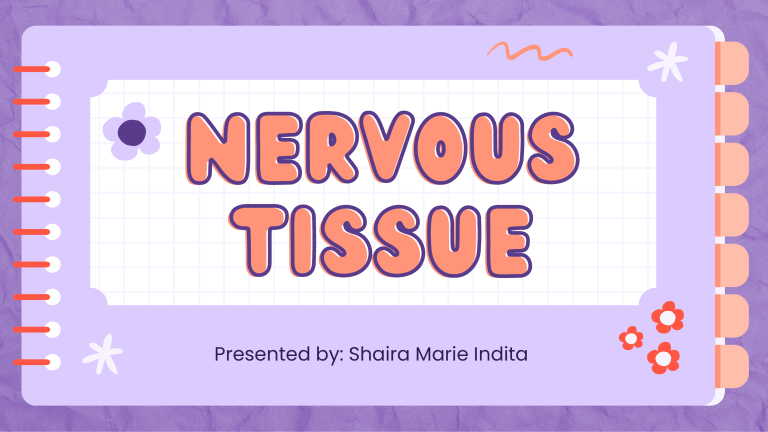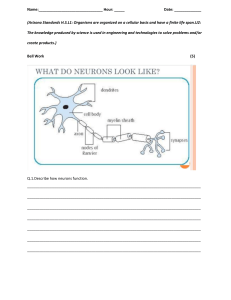
NERVOUS TISSUE Presented by: Shaira Marie Indita overview ❖ Formed by a network of many billion nerve cells (neurons), all assisted by many more supporting cells called glial cells. ❖ Each neuron has hundreds of interconnection with other neurons, forming a very complex system for processing information and generating responses ❖ Anatomically, the general organization of nervous system has 2 major divisions: o Central Nervous System (CNS) o Peripheral Nervous System (PNS) N E IN U R TH UL EM E A T BR EA IO YO RL N Y ❖ The nervous system develops from the outermost of the three early embryonic layers, the ectoderm, beginning in the third week of development ❖ With signals from the underlying axial structure, the notochord, ectoderm on the mid-dorsal side of the embryo thickens to form the epithelial neural plate. ❖ The lateral sides of this plate fold upward, bend and grow toward each other medially, and within a few days fuse to form the neural tube. neurons neurons • The functional unit in both CNS and PNS • Consists of 3 main parts: Cell body or perikaryon Dendrites Axon neurons • Neurons can be classified according to the number of processes extending from the cell body: Multipolar neurons – one axon and 2 or more dendrites Bipolar neurons – one dendrite and one axon Unipolar or pseudounipolar neurons Anaxonic neurons – single process that bifurcates close to the perikaryon, with longer branch extending to a peripheral ending and the other toward the CNS – many dendrites but no true axon, do not produce action potentials, but regulate electrical changes of adjacent neurons Note: Most neurons are multipolar. Bipolar neurons are found in the retina, olfactory mucosa, and the cochlear and vestibular ganglia, where they serve the sense of sight, smell, and balance. Pseudounipolar neurons are found in the spinal ganglia and in most cranial ganglia. NERVOUS COMPONENTS CAN ALSO BE SUBDIVIDED FUNCTIONALLY: • Sensory neurons are afferent and receive stimuli fom the receptors throughout the body. • Motor neurons are efferent, sending impulses to effector organs such as muscle fibers and glands. • Somatic motor nerves are under voluntary control and typically innervate most skeletal muscle; autonomic motor nerves control the “involuntary” activities of the glands, cardiac muscle, and most smooth muscle. • Interneurons establish relationships among other neurons, forming complex functional networks or circuits in the CNS. In the CNS most perikaryal occur in the gray matter, with axons concentrated in the white matter. In the PNS cell bodies are found in ganglia and in some sensory regions, such as olfactory mucosa, and axons are bundled in nerves. • Is the neuronal region that contains the nucleus and surrounding cytoplasm. • The chromatin is finely dispersed, reflecting the intense synthetic activity. • Cytoplasm of perikaryon have concentrated RER that appear as clumps of basophilic material called chromatic substance (or Nissl substance, Nissl bodies) CELL BODY (PERIKARYON) dendrites • they are usually short and divided like tree branches • usually covered the synapses and are the principal reception and processing sites on neurons. • Most neurons have only one axon, a fine cylindrical process that varies in length and diameter according to type of neuron. • Originate from a pyramid-shaped region of the perikaryon called the axon hillock. AXONS • The plasma membrane of the axon is called axolemma and its contents are known as axoplasm. • The distal end of an axon forms a terminal arborization, and axons of interneurons and some motor neurons have branches called collaterals that end at synapse influencing the activity of many other neurons. • Each branch ends with a dilation called terminal bouton that contacts a non-nerve cell at a synapse to initiate an impulse in that cell. neuron action potential • Are sites where nerve impulses are transmitted from one neuron to another or from neurons and other effector cells. The structure of a synapse ensures that transmission is unidirectional. • Synapses convert an electrical signal (nerve impulse) from the presynaptic cell into a chemical signal that affects the postsynaptic cell. • Most synapse act by releasing neurotransmitters, which are usually small molecules that bind specific receptor proteins to either open or close ion channels or initiate second-messenger cascades. SYNAPSE COMPONENTS OF A SYNAPSE • Presynaptic axon terminal (terminal bouton) • Postsynaptic cell membrane • Synaptic cleft MORPHOLOGICAL TYPES OF SYNAPSES • If an axon forms a synapse with a cell body, it is called axosomatic synapse; with a dendrite, axodendritic; or with another axon, axoaxonic. GLIAL CELLS • Support neuronal survival and activities, and are 10x more abundant than neurons. • Like neurons, most glial cells develop from progenitor cells of the embryonic neural plate. • There are six kinds of glial cells: o Oligodendrocytes o Schwann cell (neurolemmocyte) o Satellite cells o Ependymal cells o Microglia GLIAL CELLS • Support neuronal survival and activities, and are 10x more abundant than neurons. • Like neurons, most glial cells develop from progenitor cells of the embryonic neural plate. • There are six kinds of glial cells: o Oligodendrocytes o Schwann cell (neurolemmocyte) o Satellite cells o Ependymal cells o Microglia ASTROCYTES • Have a large number of radiating processes and are also unique to the CNS. • Most numerous glial cells of the CNS, as well as the most diverse structurally and functionally • Fibrous astrocytes – typical in the white matter and have a relatively few long processes • Protoplasmic astrocytes – predominate in the gray matter and have many shorter, branched processes • The larger processes of all astrocytes are reinforced with bundles of intermediate filaments made of glial fibrillary acid protein (GFAP), which serves as the unique marker for astrocytes, the most common source of brain tumors. v6y EPENDYMAL CELLS • Columnar or cuboidal cells that line the ventricles of the brain and central canal of the spinal cord. • In some CNS locations, the apical ends of ependymal cells have cilia, which facilitates the movement of the CSF and long microvilli, which are likely involved in absorption. EPENDYMAL CELLS • Columnar or cuboidal cells that line the ventricles of the brain and central canal of the spinal cord. • In some CNS locations, the apical ends of ependymal cells have cilia, which facilitates the movement of the CSF and long microvilli, which are likely involved in absorption. MICROGLIA • Small cells with short irregular processes evenly distributed throughout gray and white matter • Secrete a number of immunoregulatory cytokines and constitute the major mechanism of immune defense in the CNS • Do not originate from neural progenitor cells like other glia, but coming from circulating blood monocytes SCHWANN CELLS • Also known as neurolemmocytes; found only in the PNS and differentiate from precursors in the neural crest • Serve as the myelinating cells of peripheral neurons SCHWANN CELLS SATELLITE CELLS OF GANGLIA • Also known as neurolemmocytes; found only in the PNS and differentiate from precursors in the neural crest • Form an intimate covering layer over the large neuronal cell bodies in the ganglia of the PNS • Serve as the myelinating cells of peripheral neurons • Regulates nutrient and waste exchange for cell bodies in ganglia • Electrically insulates PNS cell bodies CENTRAL NERVOUS SYSTEM • Major regions of the CNS are: cerebrum, cerebellum, and the spinal cord • The entire CNS displays organized areas of white matter and gray matter, differences caused by the differential distribution of myelin. • Meninges o Membranes of connective tissue located between the bone and nervous tissue of the CNS. o 3 meningeal layers: dura mater, arachnoid, and pia matter BLOOD-BRAIN BARRIER • Functional barrier that allows much tighter control than that in most tissues over the passage of substances moving from blood into the CNS tissue. • Main structural component → capillary endothelium, in which cells are tightly sealed together with well-developed occluding junctions. • The limiting layer of perivascular astrocytic feet that completely envelops the basal lamina of the capillaries in most CNS regions forms another BBB components and further regulates passage of molecules and ions from blood to brain. choroid plexus • Consists of highly specialized tissue with elaborate folds and many villi • The funtion of the choroid plexus is to rmeove water from blood and release it as the CSF. • Arachnoid villi provide the main pathway for absorption of CSF back into the venous circulation PERIPHERAL NERVOUS SYSTEM • Main components: nerves, ganglia, and nerve endings o Nerves are bundles of nerve fibers (axons) surrounded by Schwann cells and layers of connective tissue. o Peripheral nerves consist of axons from motor neurons (in the spinal cord), sensory neurons and autonomic neurons (in ganglia); all the axons are enclosed within a series of Schwann cells, but only large (myelinated) axons have myelin sheaths and nodes of Ranvier. PERIPHERAL NERVOUS SYSTEM • Endoneurium – a thin connective tissue layer immediately surrounding Schwann cells in peripheral nerves. • Group of axons are surrounded by perineurium, consisting of layered, squamous fibroblastic cells joined by tight junctions to make a bloodnerve barrier. • Surrounding the perineurium is a thick, outermost later of dense irregular connective tissue, the epineurium. • Ganglia. Which can either be sensory or autonomic, contain neuronal cell bodies and their satellite cells. THANK YOU!!!







